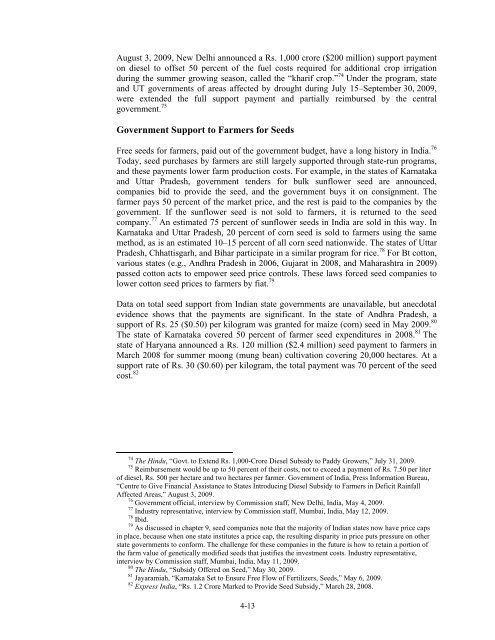India: Effects of Tariffs and Nontariff Measures on U.S. ... - USITC
India: Effects of Tariffs and Nontariff Measures on U.S. ... - USITC
India: Effects of Tariffs and Nontariff Measures on U.S. ... - USITC
You also want an ePaper? Increase the reach of your titles
YUMPU automatically turns print PDFs into web optimized ePapers that Google loves.
August 3, 2009, New Delhi announced a Rs. 1,000 crore ($200 milli<strong>on</strong>) support payment<br />
<strong>on</strong> diesel to <str<strong>on</strong>g>of</str<strong>on</strong>g>fset 50 percent <str<strong>on</strong>g>of</str<strong>on</strong>g> the fuel costs required for additi<strong>on</strong>al crop irrigati<strong>on</strong><br />
during the summer growing seas<strong>on</strong>, called the “kharif crop.” 74 Under the program, state<br />
<str<strong>on</strong>g>and</str<strong>on</strong>g> UT governments <str<strong>on</strong>g>of</str<strong>on</strong>g> areas affected by drought during July 15–September 30, 2009,<br />
were extended the full support payment <str<strong>on</strong>g>and</str<strong>on</strong>g> partially reimbursed by the central<br />
government. 75<br />
Government Support to Farmers for Seeds<br />
Free seeds for farmers, paid out <str<strong>on</strong>g>of</str<strong>on</strong>g> the government budget, have a l<strong>on</strong>g history in <str<strong>on</strong>g>India</str<strong>on</strong>g>. 76<br />
Today, seed purchases by farmers are still largely supported through state-run programs,<br />
<str<strong>on</strong>g>and</str<strong>on</strong>g> these payments lower farm producti<strong>on</strong> costs. For example, in the states <str<strong>on</strong>g>of</str<strong>on</strong>g> Karnataka<br />
<str<strong>on</strong>g>and</str<strong>on</strong>g> Uttar Pradesh, government tenders for bulk sunflower seed are announced,<br />
companies bid to provide the seed, <str<strong>on</strong>g>and</str<strong>on</strong>g> the government buys it <strong>on</strong> c<strong>on</strong>signment. The<br />
farmer pays 50 percent <str<strong>on</strong>g>of</str<strong>on</strong>g> the market price, <str<strong>on</strong>g>and</str<strong>on</strong>g> the rest is paid to the companies by the<br />
government. If the sunflower seed is not sold to farmers, it is returned to the seed<br />
company. 77 An estimated 75 percent <str<strong>on</strong>g>of</str<strong>on</strong>g> sunflower seeds in <str<strong>on</strong>g>India</str<strong>on</strong>g> are sold in this way. In<br />
Karnataka <str<strong>on</strong>g>and</str<strong>on</strong>g> Uttar Pradesh, 20 percent <str<strong>on</strong>g>of</str<strong>on</strong>g> corn seed is sold to farmers using the same<br />
method, as is an estimated 10–15 percent <str<strong>on</strong>g>of</str<strong>on</strong>g> all corn seed nati<strong>on</strong>wide. The states <str<strong>on</strong>g>of</str<strong>on</strong>g> Uttar<br />
Pradesh, Chhattisgarh, <str<strong>on</strong>g>and</str<strong>on</strong>g> Bihar participate in a similar program for rice. 78 For Bt cott<strong>on</strong>,<br />
various states (e.g., Andhra Pradesh in 2006, Gujarat in 2008, <str<strong>on</strong>g>and</str<strong>on</strong>g> Maharashtra in 2009)<br />
passed cott<strong>on</strong> acts to empower seed price c<strong>on</strong>trols. These laws forced seed companies to<br />
lower cott<strong>on</strong> seed prices to farmers by fiat. 79<br />
Data <strong>on</strong> total seed support from <str<strong>on</strong>g>India</str<strong>on</strong>g>n state governments are unavailable, but anecdotal<br />
evidence shows that the payments are significant. In the state <str<strong>on</strong>g>of</str<strong>on</strong>g> Andhra Pradesh, a<br />
support <str<strong>on</strong>g>of</str<strong>on</strong>g> Rs. 25 ($0.50) per kilogram was granted for maize (corn) seed in May 2009. 80<br />
The state <str<strong>on</strong>g>of</str<strong>on</strong>g> Karnataka covered 50 percent <str<strong>on</strong>g>of</str<strong>on</strong>g> farmer seed expenditures in 2008. 81 The<br />
state <str<strong>on</strong>g>of</str<strong>on</strong>g> Haryana announced a Rs. 120 milli<strong>on</strong> ($2.4 milli<strong>on</strong>) seed payment to farmers in<br />
March 2008 for summer mo<strong>on</strong>g (mung bean) cultivati<strong>on</strong> covering 20,000 hectares. At a<br />
support rate <str<strong>on</strong>g>of</str<strong>on</strong>g> Rs. 30 ($0.60) per kilogram, the total payment was 70 percent <str<strong>on</strong>g>of</str<strong>on</strong>g> the seed<br />
cost. 82<br />
74 The Hindu, “Govt. to Extend Rs. 1,000-Crore Diesel Subsidy to Paddy Growers,” July 31, 2009.<br />
75 Reimbursement would be up to 50 percent <str<strong>on</strong>g>of</str<strong>on</strong>g> their costs, not to exceed a payment <str<strong>on</strong>g>of</str<strong>on</strong>g> Rs. 7.50 per liter<br />
<str<strong>on</strong>g>of</str<strong>on</strong>g> diesel, Rs. 500 per hectare <str<strong>on</strong>g>and</str<strong>on</strong>g> two hectares per farmer. Government <str<strong>on</strong>g>of</str<strong>on</strong>g> <str<strong>on</strong>g>India</str<strong>on</strong>g>, Press Informati<strong>on</strong> Bureau,<br />
“Centre to Give Financial Assistance to States Introducing Diesel Subsidy to Farmers in Deficit Rainfall<br />
Affected Areas,” August 3, 2009.<br />
76 Government <str<strong>on</strong>g>of</str<strong>on</strong>g>ficial, interview by Commissi<strong>on</strong> staff, New Delhi, <str<strong>on</strong>g>India</str<strong>on</strong>g>, May 4, 2009.<br />
77 Industry representative, interview by Commissi<strong>on</strong> staff, Mumbai, <str<strong>on</strong>g>India</str<strong>on</strong>g>, May 12, 2009.<br />
78 Ibid.<br />
79 As discussed in chapter 9, seed companies note that the majority <str<strong>on</strong>g>of</str<strong>on</strong>g> <str<strong>on</strong>g>India</str<strong>on</strong>g>n states now have price caps<br />
in place, because when <strong>on</strong>e state institutes a price cap, the resulting disparity in price puts pressure <strong>on</strong> other<br />
state governments to c<strong>on</strong>form. The challenge for these companies in the future is how to retain a porti<strong>on</strong> <str<strong>on</strong>g>of</str<strong>on</strong>g><br />
the farm value <str<strong>on</strong>g>of</str<strong>on</strong>g> genetically modified seeds that justifies the investment costs. Industry representative,<br />
interview by Commissi<strong>on</strong> staff, Mumbai, <str<strong>on</strong>g>India</str<strong>on</strong>g>, May 11, 2009.<br />
80 The Hindu, “Subsidy Offered <strong>on</strong> Seed,” May 30, 2009.<br />
81 Jayaramiah, “Karnataka Set to Ensure Free Flow <str<strong>on</strong>g>of</str<strong>on</strong>g> Fertilizers, Seeds,” May 6, 2009.<br />
82 Express <str<strong>on</strong>g>India</str<strong>on</strong>g>, “Rs. 1.2 Crore Marked to Provide Seed Subsidy,” March 28, 2008.<br />
4-13

















